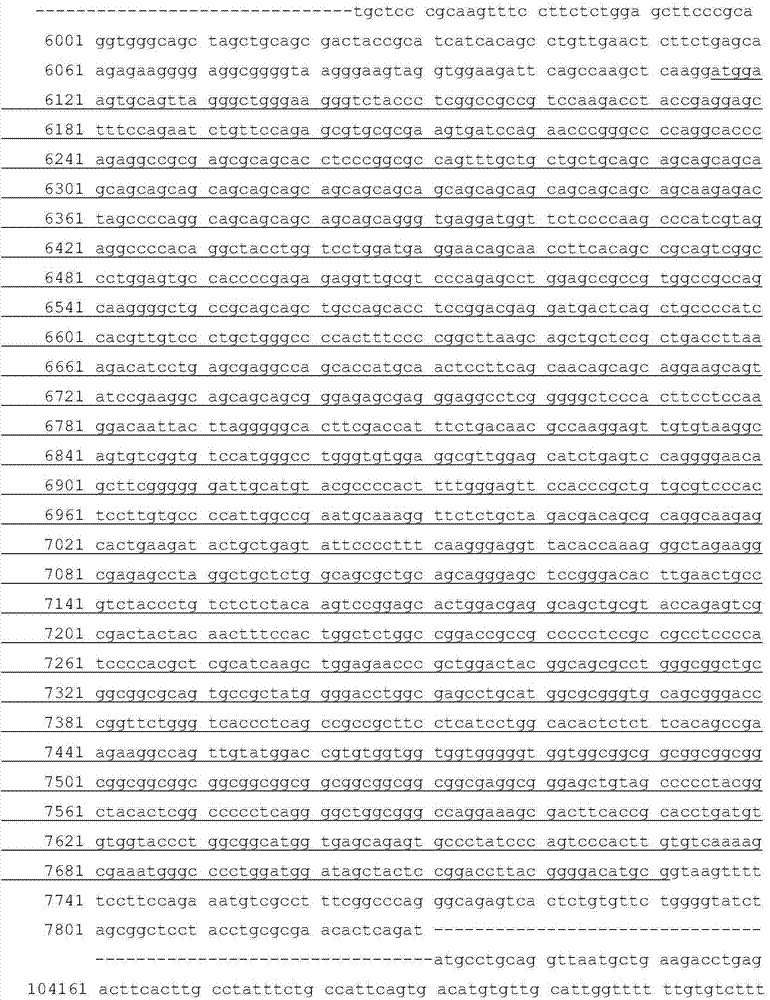TALEN and pMD18 vector-based site-directed mutagenesis system and its application
A technology of TALEN-L and site-directed mutagenesis, which is applied in the direction of introducing foreign genetic material using vectors, recombinant DNA technology, hydrolytic enzymes, etc., can solve the problems of inability to directly obtain 100% edited cells and low efficiency, and achieve simplification of manual labor, The effect of clear genetic background, efficient and precise editing
- Summary
- Abstract
- Description
- Claims
- Application Information
AI Technical Summary
Problems solved by technology
Method used
Image
Examples
Embodiment 1
[0069] AR Sequence Analysis of Human Androgen Receptor Gene
[0070] The sequence of the human androgen receptor gene AR (NG_009014.2) was downloaded from the NCBI database. Sequence analysis shows that the gene includes 8 exons and 7 introns, such as figure 2 shown. According to the general principle of gene knockout, the second and third exons of the gene are ideal knockout target sites, and the second exon is used as the knockout target sequence in this embodiment.
[0071] sequence design
[0072] According to the sequence characteristics of the human androgen receptor gene AR, we selected the sequence on the second exon as the target sequence of TALEN. The nucleotide sequence of the second exon of the human androgen receptor gene AR is as follows: figure 2 As shown, according to the TALEN principle, the nucleotide sequences SEQ ID NO.1 and SEQ ID NO.2 with the structure T (N11-18) are used as the target sites recognized by TALEN, where N is A, G, T and C any base. ...
Embodiment 2
[0084] The difference between Example 2 and Example 1 is: ① The purpose of Example 2 is to construct five human androgen receptor AR point mutants, while the purpose of Example 1 is to knock out AR and make it inactive; ② Based on the difference between Example 2 and Example 1, the recognition sites of TALEN-L and TALEN-R are downstream of the 8th exon of the human androgen receptor AR gene, such as figure 2 shown; ③ based on the point mutation sites in Example 2 are located in the 8th exon of the AR gene, so they can share the right arm of homologous recombination, such as Figure 11 As shown, it was amplified by primers SEQ ID NO.18 and SEQ ID NO.19; ④The five kinds of AR point mutants were all artificially designed and synthesized primers to bring in the mutation site, and the mutation site was all downstream primers (such as SEQ ID NO. 10, 12, 14, 15, 17), the product is as follows Figure 6-10 shown. Moreover, there is a puromycin resistance gene between the upstream a...
PUM
 Login to View More
Login to View More Abstract
Description
Claims
Application Information
 Login to View More
Login to View More - R&D
- Intellectual Property
- Life Sciences
- Materials
- Tech Scout
- Unparalleled Data Quality
- Higher Quality Content
- 60% Fewer Hallucinations
Browse by: Latest US Patents, China's latest patents, Technical Efficacy Thesaurus, Application Domain, Technology Topic, Popular Technical Reports.
© 2025 PatSnap. All rights reserved.Legal|Privacy policy|Modern Slavery Act Transparency Statement|Sitemap|About US| Contact US: help@patsnap.com



